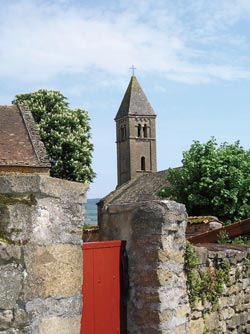In Burgundy's wine country, young people find peace and perspective on retreat at a monastery in Taize.
At first there is fidgeting. And clearing of throats. Legs crossed and uncrossed, positions shifted. But slowly the silence descends, and there is stillness. For 15 whole minutes, hundreds of teenagers and young adults are alone-together-with their thoughts and with their God.
Then one of 70 monks in white robes kneeling down the middle of the warehouse-like chapel begins to sing: "Jesus, remember me/When you come into your kingdom. Jesus, remember me/When you come into your kingdom." Now the entire congregation is chanting this prayerful plea, their accents revealing that, for most of them, English is not their first language. Earlier in the prayer service, they sang simple songs in French, German, Spanish, and Latin: "Mon âme se repose," "Bleibet hier," "Padre nuestro," "Ubi caritas."
It is this music for which the monastery at Taizé, France is perhaps best known in the United States. Some parishes use it during Mass; a growing number host weekly or monthly "Taizé prayer services," modeled on the thrice daily community prayer at the monastery.
But the music is just a small piece of the Taizé experience. The ecumenical monastery, founded in 1949 and dedicated to reconciliation among all people but particularly among Christians, has become one of the world's most popular pilgrimage sites for young people. The monks' open, nonjudgmental attitude, the monastery's setting in the idyllic French countryside, and an increasing hunger for silence and spirituality have made it attractive to hundreds of thousands of pilgrims from all around the world and from a variety of religious backgrounds.
Today a second generation of pilgrims is coming to Taizé; some of their parents even met here. Visitors typically stay for one week, living in simple, rustic barracks or tents, participating in community prayer and Bible study, and contributing to the community life through an assigned job. If you're lucky, it's not cleaning toilets.
"Nothing really extraordinary happens here, even though a lot of people have extraordinary stories and experiences," says 29-year-old Ryan Andersen of Calgary, Canada, who returned to Taizé for the second time after finishing graduate school. "It's really just routine, but that routine brings richness. Young people are struggling with their faith-that's why they end up here. It's a place to reflect. Something about being silent teaches you."
That routine begins at 8 a.m. with a simple breakfast of tea, bread, and a small bit of chocolate, followed by morning prayer. Visitors are then assigned to small groups for study and sharing led by one of the monks. Then it's time for prayer again and lunch. Afternoons are free, and many spend the time in silence in "The Source," a section of the grounds with paths, a lake, and plenty of nature. Before you know it, it's time for dinner (perhaps some lentil stew and crusty bread with a bowl for water from the tap) and evening prayer.
Global gathering
After evening prayer, the rule of silence applies everywhere-everywhere except "Oyak," a snack shop/bar at the edge of the grounds open for a few hours each night. It's here that visitors can buy a hamburger to supplement that simple dinner, or grab a beer and chat with others they have met during the day. Though some come to Taizé in groups, many arrive solo.
Oyak is a veritable mini-United Nations, with people from nearly every continent mingling. Aidan Bartlett, 21, of England is joking with an American about the BBC television show The Office. His father is an Anglican minister, but he came to Taizé after hearing about the founder's slaying last year. "I needed an escape and a place where I had time to myself. I've been going through a rough time and asking a lot of questions," says Bartlett, who is planning an extended stay of several months. "Being here has reaffirmed my faith. And it has settled me down quite a bit," he adds with a smile, then turns to make plans to meet an attractive young woman later.
Seventeen-year-old Thomas Vincent-Sweet of France has been coming to Taizé all his life, first with his family and now alone before heading off to college. "My favorite part of Taizé is meeting so many other young people, people who are from all over and speak different languages," he says. He has made friends from the United States, New Zealand, Germany, Poland, and South Africa. "I even fell in love here," he shares, although the young woman from Sweden is now engaged to someone else.
Many of the pilgrims are facing transitions in their lives. Andrew Pickard, 22, of Australia is considering whether to play cricket professionally in England. His parents brought him to Taizé when he was 6; now he has returned for a six-month stay. "Although it looks like there is not a lot of freedom here, there really is freedom because this is an open-minded place. There's freedom in the soul," he says. "There are expectations about how you engage with the community but not expectations about what you should or shouldn't be doing with your life. You are just encouraged to be real. You're not condemned or judged.
"We are all wrestling with things," he adds. "But here you ask the questions instead of just going on with your life. You go below the surface, rather than just do what you're told to do. You can listen to the Spirit."
Be still and know
This openness to searching and doubt is a hallmark of Taizé and comes directly from the monastery's founder, Brother Roger. "Young people don't always have the words for it, but there's a searching inside. Too often we adults interpret their silence as indifference to faith," says Brother Emile, a monk originally from Canada. "At Taizé, they see others searching. And they know it's a place where you can search with freedom; they're not asked for results. You can come as you are, with your questions and doubts. They can ground themselves in the rhythm of the place."
That rhythm is centered around prayer, especially the common prayer three times a day. "The goal of Taizé is the possibility of meeting with God," says Brother Jose-Ramon of Puerto Rico. "That encounter takes place most of the time in prayer, so we spend a lot of time praying. Prayer is the space where God welcomes us. With God there is no misunderstanding. God understands every language, including silence."
For 21st-century young adults who are rarely disconnected from their iPods or cell phones, the idea of a week-or more-filled with so much silence can seem overwhelming but ultimately refreshing. "I'm not used to so much silence, and at first it was unsettling," admits Vincent-Sweet of France. "But then you discover how to use it. The songs are so meditative, they put you in a trance. Sometimes you fall asleep. But I've learned to pray during the silence."
Krystle Martinez, 21, is traveling with a group from Schreiner University, a Presbyterian college in Texas. She graduated last year and now works for the San Antonio Police Department and is president of the Catholic young adult group at the school. "I normally don't have time for silence," she says. "This is something completely different, something I've never experienced before, even at Mass. You don't have all the distractions of home. You can be yourself and know what you're feeling. You feel yourself in the presence of God here. It's sacred space."













Add comment